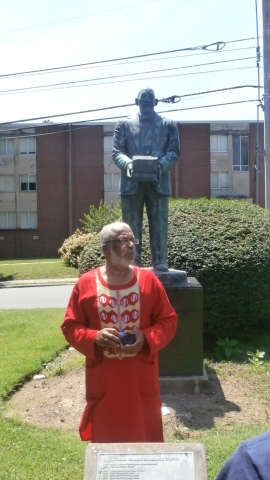During our second to last day of our Civil Rights Tour, we toured Nashville with Mr. Kwame Lillard (pictured below in front of a statue of W.E.B Dubois) who was one of the hundreds of students in the Nashville who occupied lunch counters and called for boycotts of the white-owned stores and businesses that held to strict segregationist policies and practices in Nashville. In 1960 with the energy and pressure from students from the four historically black colleges in the area, clergy and other individuals, the mayor agreed to order all the businesses in Nashville to desegregate and for schools to likewise become integrated. The next year many of these same students, plus hundreds of others both black and white, rode buses in “freedom rides” through the South to challenge the segregationist policies of the those states. Many of them were beaten and nearly all were put in prison until the FCC ordered that all interstate vehicles and facilities be desegregated as required by federal law. As Mr. Lillard shared with us, Nashville was a center of many civil rights activities and many of the leaders of the movement got their start in Nashville.
Yet few history books mention Nashville when talking about the Civil Rights Movement and so the city is better known for its country music than its critical role in the Movement. The Nashville story is just one of the many aspects of the history of this country that is either ignored or conveniently forgotten. The dominant narrative asserts that the United States is a bastion of freedom and justice. Yet the true history is far more complex than the story told in most U.S. history textbooks. Whether talking about the near genocide of Native Americans, the colonization of people living in the lands annexed during the Louisiana Purchase, the internment of Japanese-Americans during World War II, the exploitation of workers from Ireland, Eastern Europe, China and Japan, or the horrific enslavement of African slaves, there are huge aspects of “U.S. history” that have been swept under the rug.
Kwame Lillard and others in Nashville are seeking to document and create museums to remember their Civil Rights history. In nearly every city we have visited, we have heard similar stories of dedicated citizens, many of them veterans of the Civil Rights movement and their descendants coming together to create museums, memorials, tours and curricula to help all people of all races remember that this is part of our history just as much as the Boston Tea Party, the Civil War and the New Deal. More importantly this history is still being felt today in the problems and struggles we currently face.
This is not a history just for African-American folks but for people of all races. As a white person, I am saddened and deeply shamed by the actions of white people supposedly acting on my behalf. However, more than that I am moved to tell others these stories so we may not repeat the atrocities of our past. For the history of racism is a part of white history that has been conveniently either domesticated or forgotten, literally “white-washed.” We who are white need to learn from this history not only the gross atrocities committed but the mindset that perpetrated and allowed them to happen. For as Martin Luther King reminded us in his “Letter from a Birmingham Jail” those who choose to step aside and not stop evil that is being foisted upon others, are as bad as those who perpetrate the evil. The passive reluctance of so-called “moderate” whites is as much a part of the Civil Rights story as the heroic actions of those who challenge the racist structures and practices of their times.
The lesson of this history is that none of us can stand aside when violence, injustice and discrimination are being enacted against anyone in our society whether they be gay, immigrant, woman, poor, young, old, from another religion, or a person of color. This a lesson we have not yet fully learned and so need to revisit again and again.
Related


